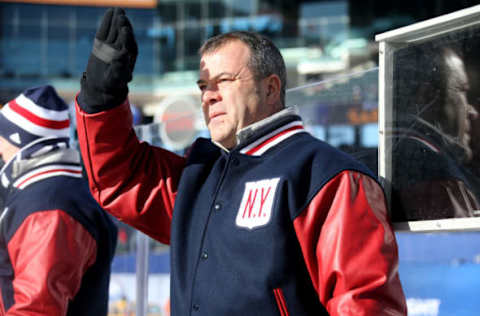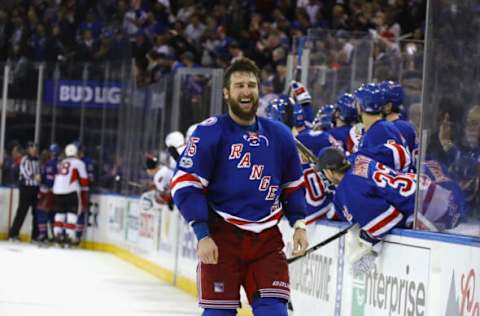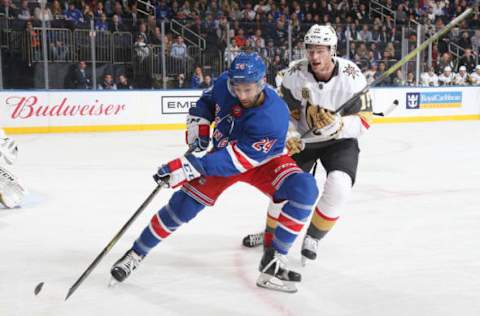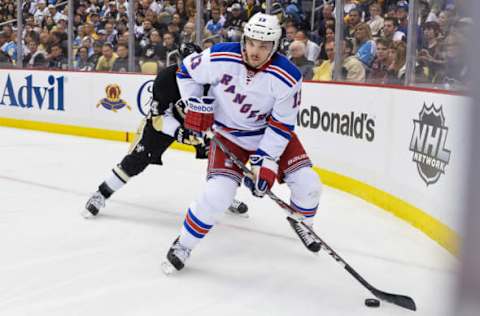New York Rangers: Five best fourth lines under Alain Vigneault


The New York Rangers have relied heavily on rolling four balanced lines during coach Alain Vigneault’s tenure.
The fourth line played a vital part in the Rangers’ Stanley Cup appearance in 2013-2014. In an ideal scenario, Alain Vigneault likes to roll his lines evenly and attack with four lines that are fresh.
In the past, a team’s fourth line would be a bruiser line that’s main job was to be physical and cause disruption. Now, things have changed. The Penguins are back-to-back Stanley Cup Champions because of their offensive depth.
The Islanders’ fourth line a few seasons back of Matt Martin, Casey Cizikas and Cal Clutterbuck was one of their most effective lines since they were able to put points on the board while maintaining a physical edge. Fourth lines are expected to chip in offensively. The Rangers have had some notably productive fourth lines as well. Let’s see which have been the five best in Vigneault’s five years with the team.

#5: 2015-16: Tanner Glass-Dominic Moore-Viktor Stalberg
The year after the New York Rangers won the President’s Trophy was a bit of a letdown. After failing to reach the cup in Vigneault’s first two seasons, the Rangers were eliminated in round one by the Pittsburgh Penguins in his third season.
Forward depth was certainly an issue as were line combinations. However, his fourth line of Glass, Moore, and Stalberg proved to be mildly efficient. Stalberg signed a one year contract prior to the 2016-2016 season and scored nine goals and 11 assists for 20 points in 75 games.
When that line was formed in early March, they were one of the Rangers’ better lines right away. The line had good skaters in Stalberg and Moore and all three were solid on the forecheck. That season, Rick Nash said that line was the best line on the team when it was put together. This was the last season for Stalberg and Moore on the Rangers, and it wasn’t a pretty ending. But, this team did finish with 101 points.

#4: 2016-17: Michael Grabner-Brandon Pirri-Jesper Fast
The following season, the Rangers brought in more speed to get back to their team identity. Brandon Pirri finally found a new home, and Michael Grabner was signed to a two-year deal after a short stint with the Toronto Maple Leafs.
Right off the bat, Vigneault paired the two with the hard-working Jesper Fast. While Grabner and Pirri would move up and down the lineup throughout the season, this line got off to a hot start. Grabner scored the first goal of the season in the season opener against the New York Islanders with assists from Pirri and Fast.
Grabner would go on to have his best season since the 2010-11 season, and total 40 points. He flourished on a line with J.T. Miller and Kevin Hayes, but there’s no doubt this line had potential.
The speed of this line showed the Rangers were back and re-tooled towards being a quick transition team. “He wants to go,” Pirri told the New York Times. “That’s the strength of his game.”

#3: 2017-2018: Paul Carey-Boo Nieves-Jesper Fast
This season, the Rangers have constantly shuffled their lines in an attempt to find something that works. After a dismal start, Vigneault is still struggling to get his team to play consistently. However, what has been consistent is his fourth line.
The two consistent players on the fourth line are Paul Carey and Boo Nieves. Nieves was called up from the Hartford Wolfpack and given a roster spot this season. He’s played 26 of the 42 games so far. Since being called up, he’s shown an ability to be strong defensively while still finding his touch offensively.
Paul Carey has been on the fourth line since the season began. The 29-year-old has played 30 games so far this season, more games then he has played in his entire career entering the season. He has five goals and five assists with a notable goal at the Winter Classic. The fourth line was the Rangers’ best line at the Classic by far.
Fast has rotated on and off this line, with Pavel Buchnevich, Vinni Lettieri, and David Desharnais seeing time on this line as well. This line has good speed, and is trusted by Vigneault in late game situations.

#2: 2014-15: Tanner Glass-Dominic Moore-Lee Stempniak
Lee Stempniak was signed to a one-year contract by the New York Rangers heading into the 2014-15 season. Just the season before, the Rangers went to the Stanley Cup finals and lost against the Los Angeles Kings in five games.
Stempniak often bounced around from team-to-team, but he finally found a home on a line with Dominic Moore and Tanner Glass. Glass was never very effective with the Rangers, but had good linemates this time around to carry the load.
The Rangers were the best team in the NHL at the time and ended up winning the President’s Trophy. Stempniak had nine goals and nine assists for 18 points in 53 games. That is, before he got traded.
It was a head-scratching move to trade away a valuable fourth line piece to the Winnipeg Jets for failed prospect Carl Klingberg. In 18 games with the Jets, Stempniak had 10 points.
Vigneault only gave him an average of 12:26 TOI (time on ice). One can only wonder what could’ve been. The three had a great combination of speed and tenacity until it was broken up for no reason.

#1: 2013-2014: Brian Boyle-Dominic Moore-Derek Dorsett/Daniel Carcillo
This was by far the best fourth line under Vigneault, and it was in his first season with the Rangers. This line was arguably one of their most important and scored huge goals come playoff time.
Who can forget Brian Boyle’s game-winning goal against the Pittsburgh Penguins in game seven of the second round? Or Dominic Moore’s game-winning goal in game seven against the Montreal Canadiens in the Eastern Conference Finals?
Dorsett and Carcillo often rotated for the third spot but were equally effective. Boyle’s strong play that season got him a nice new contract the following season with the Tampa Bay Lightning.
Next: Revisiting the Mika Zibanejad-Derick Brassard trade
The biggest advantage of this line was their ability to wear you down on the forecheck, spend time in the offensive zone, and be strong defensively. The Rangers had the third-best penalty kill that season in large part to this line. Boyle and Moore were also the only centers to be over 50% in the faceoff dot.
This line didn’t light up the score-sheet, but it did all the little things that round out a team. It scored some of the most important goals on that dramatic postseason run and gave us memories to last a lifetime making it the best fourth line under Vigneault.